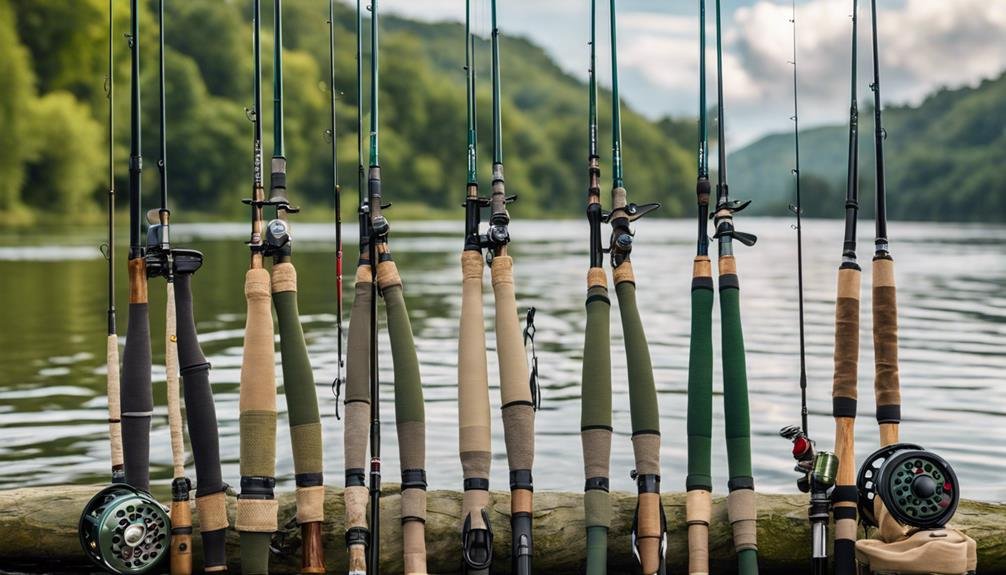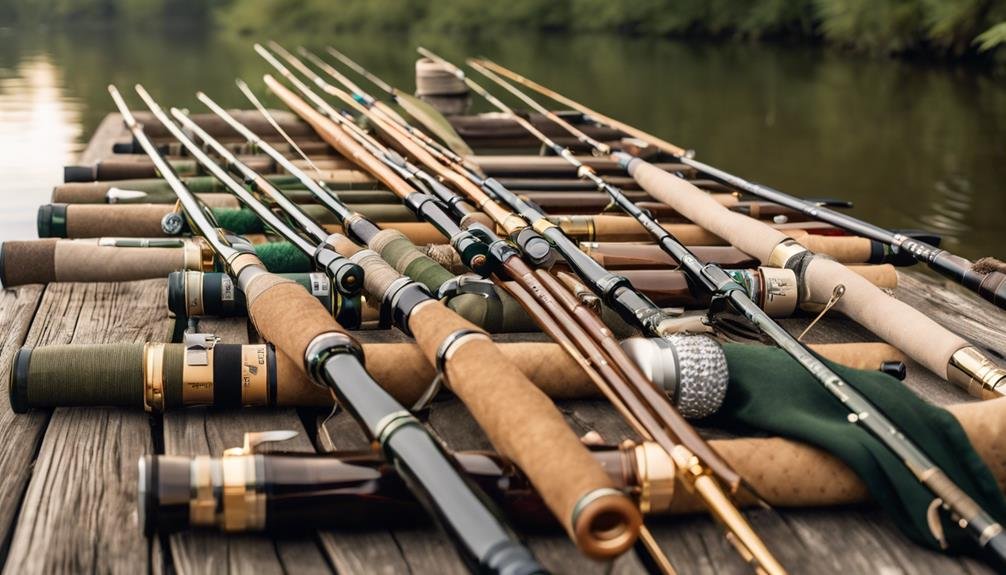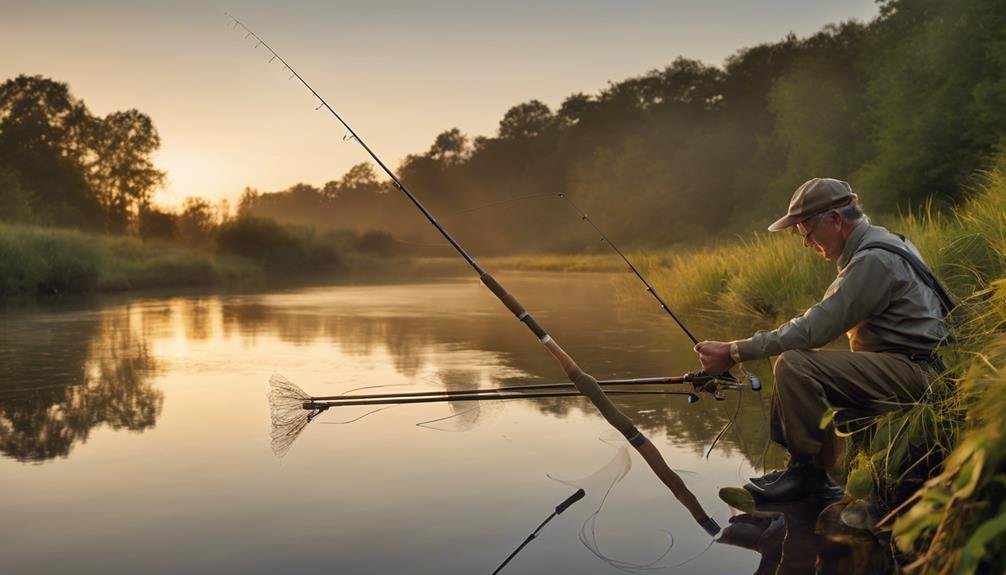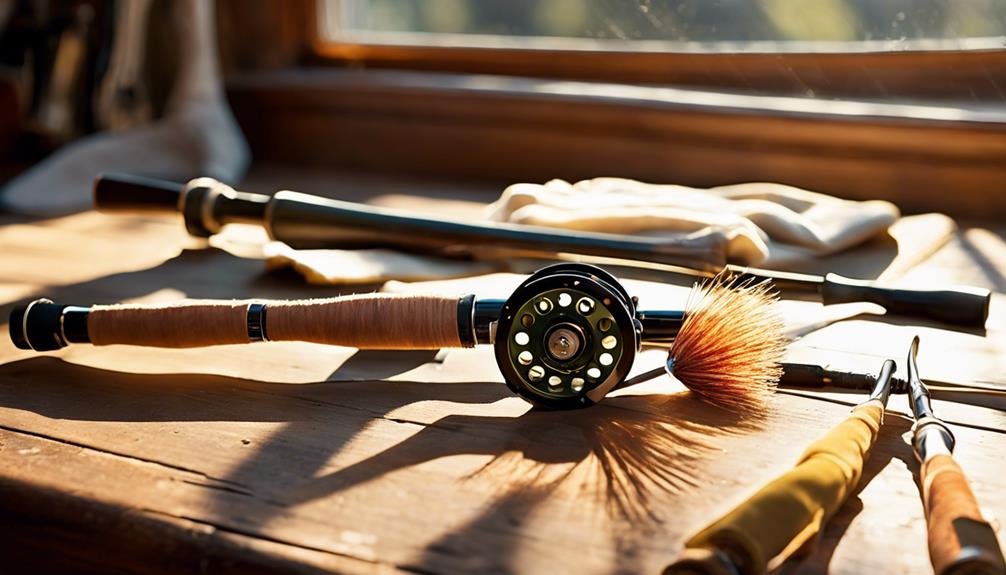When you’re selecting a fly fishing rod, understanding the variety available can make a significant impact on your fishing experience. You’ve got single-handed rods for traditional casting and double-handed Spey rods for those long-distance casts. The right choice hinges on action, weight, length, and material. Brands like Orvis, Sage, and Redington are recognized for their craftsmanship and innovative designs. But what exactly should you consider when picking the perfect rod for your needs? Let’s explore the key elements guaranteeing you’re well-equipped for a successful day on the water.
Key Takeaways
- Choose rod weight based on target fish species; lighter weights are for delicate presentations, and heavier weights are for larger fish.
- Select rod length according to the fishing environment; longer rods are for open waters, and shorter rods are for small streams.
- Consider rod action, weight, length, and material to match your fishing style and preferences.
- Popular brands like Orvis, Sage, and Redington offer high-quality craftsmanship and innovative designs.
- Bozeman FlyWorks provides budget-friendly rod packages with customization options for beginners and experienced anglers.
Types of Fly Fishing Rods

When selecting a fly fishing rod, understanding the various types accessible and their specific purposes is vital. Single-handed rods are designed for traditional fly fishing techniques. They offer versatility and can handle different environments, from small streams to larger bodies of water. You’ll appreciate their adaptability, especially when targeting different flyweights and saltwater species.
Double-handed or Spey rods excel in long-distance casting and powerful presentations. These rods are perfect for larger rivers that need to cover more water and reach distant fish. They’re commonly used for salmon and steelhead fishing, making them indispensable if you frequent these waters.
Switch rods offer a blend of single- and double-handed rod benefits. You can easily switch between casting styles, making them versatile for various situations. Switch rods adapt well when fishing in tight quarters or open spaces.
Tenkara rods, originating from Japan, are minimalist fly fishing rods. They’re highly effective in small streams due to their simplicity. With no reel, you’ll find them easy to use, focusing solely on the fly and its presentation.
Understanding these types will help you choose the best rod for your fly-fishing adventures.
Choosing the Right Fly Rod
Now that you’re familiar with the different types of fly fishing rods, it’s time to choose the one that best suits you, considering the fly rod’s action. A fast-action rod is ideal if you prefer quick, precise casts. A medium-action rod offers more versatile casting and a smoother feel. Slow-action rods provide a more relaxed casting experience for smaller streams and delicate presentations.
Next, you’ll need to select the appropriate weight for the fly the fly rod. The weight ranges from 2 to 12, with lighter weights suited for smaller fish like trout and heavier weights necessary for larger species like salmon. Match your rod weight with the fly line to ensure balanced performance.
The length of your fly rod should align with the type of water you’ll be fishing in. Shorter rods (6-8 feet) are great for tight, brushy streams, while longer rods (9-10 feet) excel in open rivers and lakes.
Material choice also plays an essential role. Graphite rods are lightweight and durable, fiberglass offers a more traditional feel, and bamboo provides a classic touch with exceptional performance. Set a realistic budget and explore options within your price range to find the best value.
Popular Fly Rod Brands

For high-quality fly fishing rods, brands like Orvis, Sage, Scott, G. Loomis, and Redington stand out for their premium craftsmanship and innovative technologies. Each brand offers unique strengths, from Orvis’s 150 years of experience to Sage’s diverse high-performance designs. Whether you prioritize exceptional casting capabilities or tactical utility, these brands have a rod that fits your needs perfectly.
Premium Craftsmanship Details
Experience and innovation intersect in the universe, where craftsmanship is crucial. When you invest in a rod from top brands like Orvis, Sage, Scott, G. Loomis, or Redington, you’re not just purchasing a tool but acquiring a piece of art refined by decades of expertise.
With over 150 years of rod-building experience, Orvis is celebrated for precision and cutting-edge technology. It offers rods tailored for saltwater, freshwater, Spey casting, small creeks, and warm-water adventures.
These brands don’t compromise on quality. They offer a range of options concerning action, weight, length, and material to match your specific fly fishing style and preferences. Whether casting in a peaceful stream or facing strong currents, you’ll find a rod that suits your needs.
The meticulous craftsmanship in these premium rods guarantees high performance and durability. Every detail, from the polished finish to the well-proportioned weight, is crafted to enhance your fishing experience. As an angler, you’ll value the commitment to producing a rod that not only meets but surpasses your expectations, providing satisfaction with every cast.
Innovative Rod Technologies
While the artistry of premium craftsmanship sets the foundation, the innovative rod technologies from brands like Orvis, Sage, Scott, G. Loomis, and Redington truly elevate your fly fishing experience. Orvis leverages 150 years of rod-building expertise to incorporate cutting-edge technology and precision engineering into its fly rods, ensuring superior rod technology advancements. Their rods are designed to optimize performance enhancements and deliver exceptional distance accuracy.
Sage’s advanced rod designs, such as the Helios series, offer unparalleled performance enhancements. These rods are renowned for their innovative design features, making them a favorite among fly anglers seeking greater distance and finesse.
G. Loomis focuses on tactical utility with their GCX Salmon and Steelhead rods, which are perfect for the demanding conditions of Pacific Northwest fisheries. Their state-of-the-art materials guarantee heightened performance and effective presentations in challenging environments.
Scott Fly Rods are celebrated for their precision engineering and high-quality materials. These rods cater to various fly fishing styles, ensuring you have the right tool for every situation.
| Brand | Key Technologies | Benefits |
|---|---|---|
| Orvis | State-of-the-art technology, precision engineering | Performance, distance accuracy |
| Sage | Advanced designs, innovative features | Distance, finesse |
| G. Loomis | Tactical utility, state-of-the-art materials | Effective presentations |
| Scott | Precision engineering, high-quality materials | Versatility |
Explore these brands to find the perfect rod that matches your fly fishing needs.
Brand-Specific Strengths
Fly fishing enthusiasts will find that each popular fly rod brand offers unique strengths tailored to different angling needs. Orvis stands out with its premium rods, featuring cutting-edge technology and precision from over 150 years of rod-building expertise. Their craftsmanship details guarantee you get a rod that’s both reliable and high-performing.
On the other hand, Sage is celebrated for its high-performance fly rods designed for diverse fishing environments—whether you’re tackling saltwater giants or freshwater trout, Sage has you covered with essential features that enhance your experience.
Scott fly rods are renowned for their innovative design and meticulous craftsmanship, making them a go-to for anglers seeking quality and performance. Their rods cater to various angling needs, ensuring you can tackle any fishing scenario confidently.
G. Loomis produces top-tier options like the GCX Salmon and Steelhead series, specifically tailored for techniques and environments such as the challenging Pacific Northwest fisheries.
For those balancing quality with affordability, Redington offers a range of reliable rods that cater to all skill levels. This brand combines quality construction with accessible pricing, making choosing the right rod easier. For premium recommendations, these brands deliver unparalleled performance and satisfaction.
Fly Rod Weight Guide
Selecting the right fly rod weight is vital for ensuring your fly fishing setup performs at its best. When making rod weight comparisons, remember that matching rod weight with your fly line is important for achieving peak performance and casting accuracy. Fly rod weights typically range from 2 to 12, where lighter weights are ideal for smaller fish and more delicate presentations, while heavier weights handle larger species and tougher conditions.
Understanding the weight designation of a fly rod helps you choose the proper gear for your target species and fishing environment. For example, a 2-4 weight rod is great for small streams and panfish, while a 5-6 weight rod is versatile enough for trout in medium-sized rivers.
On the other hand, 7-8 weight rods are better suited for bass or light saltwater, and anything from 9-12 weight is ideal for bigger game fish like salmon or tarpon.
Weight selection tips include considering the type of flies you’ll be using and the fishing situations you’ll encounter. Lighter rods offer more sensitivity and finesse, making them perfect for delicate presentations, whereas heavier rods provide extra power and durability for battling larger fish and casting bigger flies.
Fly Rod Length Considerations

The length of your fly rod greatly influences casting distance and accuracy, making it an essential factor in your fly-fishing setup. Longer rods, typically between 9 and 10 feet, offer extended reach and superior line control, necessary for larger rivers and windy conditions.
In contrast, shorter rods (6-8 feet) excel in small streams and tight spaces, giving you better control and precision.
Medium-length fly rods (8.5-9 feet) strike a balance, providing versatility across different fishing environments and species. When choosing the right length, consider your casting techniques, the fishing environment, and the target species. Your personal preference and style also matter significantly.
- Small Streams: Shorter rods are perfect for tight quarters and offer greater accuracy in small spaces.
- Versatile Waters: Medium rods adapt well to various conditions, making them a reliable choice for many anglers.
- Large Rivers: Longer rods give you the edge in casting distance and line control, which is vital for more open, wind-prone areas.
Additionally, explore different rod material comparisons to find the best fit for your needs. Don’t forget custom rod options if you have specific requirements or preferences. Remember, the right rod length can make all the difference in your fly fishing experience.
Essential Fly Rod Features
When diving into the world of fly fishing, a few key features of your fly rod can make all the difference in your overall experience.
First, consider rod material comparisons. Graphite and fiberglass are the most common materials used in fly rods. Graphite rods are lightweight and highly sensitive, making them ideal for precise casting techniques. On the other hand, fiberglass rods are more durable and provide a slower, more forgiving action, which can benefit beginners.
Next, the rod’s weight, length, and action are pivotal in determining its suitability for various fishing environments. Heavier rods are better for larger fish like salmon, while lighter rods are perfect for trout. The rod’s length also affects your casting range and accuracy. Shorter rods in tight, brushy streams offer better maneuverability, whereas longer rods excel in open waters.
Fly Rod Care Tips

To maintain your fly fishing rod in top condition, clean it thoroughly after each use to remove dirt and debris.
Avoid exposing your rod to extreme temperatures, affecting its performance and durability.
These simple steps guarantee that your rod lasts longer and performs better.
Cleaning After Use
Cleaning your fly fishing rod after a day on the water is essential to maintaining its performance and longevity. Start by rinsing your rod with fresh water to remove dirt, salt, or debris. Use a soft cloth or brush to gently scrub the rod, paying extra attention to the guides and reel seat. This simple maintenance technique will help prevent buildup that can damage your rod over time.
Regularly check your rod for any nicks or scratches that could compromise its integrity. If you find any, address them promptly to guarantee proper rod protection.
Once cleaned, dry your rod thoroughly before storing it. To safeguard it from accidental damage during transport or storage, choose storage options like a protective case or rod sock.
Here’s a quick checklist to visualize the process:
- Rinse and scrub: Use fresh water and a soft brush to clean your rod.
- Inspect for damage: Look for nicks and scratches and address them promptly.
- Store properly: Use a protective case or rod sock for safe storage.
Consistent rod care maintains your rod’s condition and results in noticeable performance improvement, ensuring reliable angling adventures.
Avoid Extreme Temperatures
Consistent cleaning isn’t the only step in maintaining your fly fishing rod; protecting it from extreme temperatures is equally important. Extreme heat or cold can wreak havoc on the materials of your rod, whether it’s made of graphite or fiberglass. The structural integrity of your rod can weaken under these conditions, leading to potential cracks or warping that ultimately affect performance.
To prevent damage, always practice temperature control. Avoid leaving your fly rod in a hot car or under direct sunlight for extended periods. These environments can cause the materials to expand or contract, compromising their durability and effectiveness in the water.
Instead, consider storage solutions that keep your rod in a more controlled environment. A climate-controlled space, such as a basement or a dedicated rod case, can greatly prolong the lifespan of your equipment.
Fly Fishing Rod Packages
Regarding fly fishing rod packages, Bozeman FlyWorks offers a variety of high-quality options tailored to different fishing needs. Whether you’re a beginner or a seasoned angler, their packages provide everything you need for a successful fishing trip. Consider the rod material comparison and personalized rod selection to make the best rod combos.
Bozeman FlyWorks packages include the Patriot, Hamilton, Midnight, Black Patriot, and Flat Gunmetal Fly Reel packages, ranging from £166.00 to £208.00. Each package combines a rod from their 406 Rod Series with a compatible reel, ensuring a balanced and efficient setup. Popular choices include:
- 9′ 7wt: Perfect for tackling bigger waters with ease.
- 9′ 8wt: Ideal for steelhead and large bass, offering strength and versatility.
- 9′ 9wt: Designed for serious fly fishers looking for performance and durability.
The 406 Rod Series is varied, featuring rods like the 8’6″ 4wt for £89.00 and the 9’10wt for £127.00. An exceptional package option is the 9’8wt with Fighting Butt for £124.00, providing extra leverage when battling larger fish. With Bozeman FlyWorks, you’ll find the perfect setup for any angling adventure.
Top Fly Rod Recommendations

Selecting the proper fly rod can significantly improve your fishing experience, and Bozeman FlyWorks offers some top recommendations.
The Bozeman FlyWorks 406 Rod Series is crafted from the best materials, ensuring durability and performance. The nine 5wt rods are a stellar choice for classic trout fishing. If you seek versatility, the ten 5wt rod can handle various situations, making it a reliable companion on different waters.
For those targeting larger fish, the nine 7wt rod is perfect for bigger waters, while the nine 8wtninerod is excellent for steelhead, large bass, or even saltwater species. Serious anglers might consider the nine 9wt rods, designed to handle tough conditions, or the nine 8wt rods with Fighting Butt for added leverage and control.
Bozeman FlyWorks also caters to a range of budgets, offering budget-friendly options without compromising quality. Additionally, they provide custom options to meet specific needs, ensuring you get the rod that’s just right for you. Whether you’re a beginner or a seasoned pro, Bozeman FlyWorks has a rod to elevate your fly fishing experience.
Conclusion
Selecting the appropriate fly fishing rod can significantly impact your angling experience. Consider the varieties, weight, length, and essential characteristics to discover the ideal fit for your requirements. Companies such as Orvis, Sage, and Redington provide high-quality choices to guarantee you’re well-prepared for success. Remember to maintain your rod to prolong its lifespan properly. You’re prepared for numerous delightful days on the water with the correct rod.
FAQs
What is a fly fishing rod?
A fly fishing rod is a specialized fishing rod designed for fly fishing, a method that uses a lightweight lure called a fly to catch fish. Fly rods are typically longer and more flexible than other fishing rods, allowing anglers to cast the lightweight fly efficiently and precisely. These rods are used to catch fish in both freshwater and saltwater environments.
Key Characteristics:
- Flexible and Lightweight: Designed for casting small, lightweight flies.
- Variety of Lengths: Typically longer than standard rods, ranging from 6 to 10 feet.
- Specific Action: Varies from fast-action to slow-action, depending on fishing needs.
How do I choose the right fly fishing rod?
Choosing the right fly fishing rod depends on several factors, including the type of fish you want to catch, the environment, and your experience level:
- Rod Length: A rod between 8 and 9 feet is versatile for most freshwater fishing. Shorter rods (6-7 feet) are ideal for tight spaces like small streams, while longer rods (9-10 feet) are better for casting in wide rivers or lakes.
- Rod Weight: Fly rods are categorized by weight, which determines the size of the fly line they can cast. Rods weighing 4-6 are versatile for trout fishing in rivers, while rods weighing 8- 10 are used for larger fish like bass or saltwater species.
- Rod Action:
- Fast-Action Rods: Stiffer and better for long-distance casting and windy conditions.
- Medium-Action Rods: Good all-around rods that offer both flexibility and casting power.
- Slow-Action Rods: These are more flexible and perfect for delicate casting in small waters.
Choosing Factors:
- Rod Length: 8-9 feet for versatility, shorter for tight spaces.
- Rod Weight: 4-6 for trout and 8-10 for larger fish.
- Rod Action: Fast, medium, or slow, depending on conditions.
What is the difference between fast-action and slow-action fly rods?
The action of a fly fishing rod refers to how much the rod bends when casting or fighting a fish:
- Fast-Action Rods: Stiff rods that bend mostly at the tip, ideal for long-distance casting, windy conditions, and large fish. They provide more power for distance but require more skill to control.
- Slow-Action Rods: More flexible rods that bend throughout the entire rod, offering better control for short, delicate casts. They are ideal for small streams and light lines but are less effective for long-distance casting.
- Medium-Action Rods: These balance fast and slow action, making them versatile for different environments and skill levels.
Rod Actions:
- Fast-Action: Stiff for long casts and large fish.
- Slow-Action: Flexible for delicate casts in small waters.
- Medium-Action: Balanced for all-around use.
How do you maintain a fly fishing rod?
Proper maintenance ensures the longevity and performance of your fly fishing rod. Here are some tips:
- Rinse After Use: When fishing in saltwater, rinse your rod with fresh water after each use to remove salt and debris.
- Inspect for Damage: Check for cracks, scratches, or wear on the rod and guides before and after each trip.
- Store Properly: When not in use, store your rod in a protective tube or case in a cool, dry place to avoid warping or damage.
- Clean the Cork Handle: Clean the cork handle with mild soap and water to prevent dirt buildup and ensure a firm grip.
Maintenance Tips:
- Rinse with fresh water after use.
- Inspect for damage regularly.
- Store in a protective case.
- Clean the cork handle to maintain grip.
What are the best fly fishing rod brands?
Several reputable brands are known for producing high-quality fly fishing rods. Some of the top brands include:
- Sage: Known for performance and innovation, Sage offers a wide range of fly rods suitable for beginners and experts.
- Orvis: A trusted name in fly fishing, Orvis rods are durable, versatile, and suitable for various fishing conditions.
- Redington: Offers affordable yet high-quality rods, perfect for beginners or those on a budget.
- G. Loomis: Known for premium fly rods that excel in performance and sensitivity.
Top Brands:
- Sage: High-performance rods for all levels.
- Orvis: Durable and versatile rods.
- Redington: Affordable and reliable for beginners.
- G. Loomis: Premium rods with excellent sensitivity.

